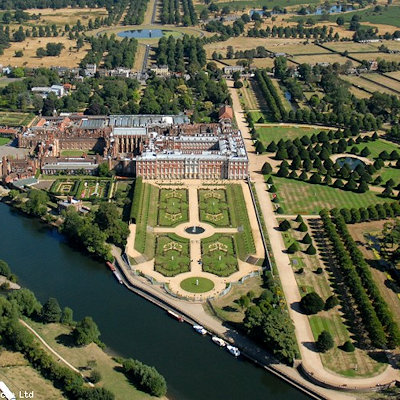
Like us on Facebook
PLACE NAMES


 
|
|
Hampton
|

|
|
 | Market Place, Kingston upon Thames - 020 8547 5592
Old Town Hall, Whittaker Avenue, Richmond - 020 8940 9125
info@kingstonfirst.co.uk
|
The Anglo-Saxon parish of Hampton converted to secular use in the 19th century included present-day Hampton, Hampton Hill, Hampton Wick and hamlet of Hampton Court surrounding Hampton Court Palace which together are called The Hamptons. The combined population of the Hamptons was 37,131 at the 2001 census. The name Hampton may come from the Anglo-Saxon words hamm meaning an enclosure in the bend of a river and ton meaning farmstead or settlement.
The ten years to 1911 saw the highest percentage of population increase. A further 25% rise took place in the 1920s. Writing between 1870-72 his national gazetteer, John Marius Wilson technically described Hampton Wick as a hamlet; the real property of which was worth almost as much as the main settlement. He furthered that the total area was 3,190 acres. Both halves had developed Urban Sanitary Districts recorded in the 1891 census Hampton and Hampton Wick were Urban Districts from 1894–1937, preceding the creation of the Borough of Twickenham, which Hampton joined.
At the edge of London, from time immemorial (before the Norman Conquest) until 1965 Hampton was in Middlesex, a former postal county also and this designation is still common in this part of the former county among residents and businesses.
Tagg's Island and much of Hampton's riverside by association became known as Thames Riviera from the 1920s: the island was leased to Fred Karno, an entertainment impresario, who opened an elevated, three-storey rambling mansard roof hotel, the Karsino in 1913, which was demolished in 1971. World War I impacted the business, which rebranded as The Thames Riviera, rivalling the hotel in Maidenhead for the name, followed by The Palm Beach and The Casino. The Riviera aspect is sometimes described in literature by the Council however is controversial among dissenters to the land use, almost wholly private housing, where Hampton's riverside is not open parkland – it is no longer endorsed by London's bus operator with a stop of that name, in the 2010s named after instead a long public meadow known as St Albans Riverside.
Hampton Court Palace is a royal palace. Redevelopment began to be carried out in 1515 for Cardinal Thomas Wolsey, a favourite of King Henry VIII. In 1529, as Wolsey fell from favour, the King seized the palace for himself and later enlarged it. Along with St James's Palace, it is one of only two surviving palaces out of the many owned by King Henry VIII.
In the following century, King William III's massive rebuilding and expansion project, which destroyed much of the Tudor palace, was intended to rival Versailles. Work ceased in 1694, leaving the palace in two distinct contrasting architectural styles, domestic Tudor and Baroque. While the palace's styles are an accident of fate, a unity exists due to the use of pink bricks and a symmetrical, if vague, balancing of successive low wings. King George II was the last monarch to reside in the palace.
Today, the palace is open to the public and is a major tourist attraction, easily reached by train from Waterloo station in central London and served by Hampton Court railway station in East Molesey, in Transport for London's Zone 6. The structure and grounds are cared for by an independent charity, Historic Royal Palaces, which receives no funding from the Government or the Crown. In addition the palace continues to display a large number of works of art from the Royal Collection.
Apart from the Palace itself and its gardens, other points of interest for visitors include the celebrated maze, the historic real tennis court, and the huge grape vine, the largest in the world as of 2005.
The palace's Home Park is the site of the annual Hampton Court Palace Festival and Hampton Court Palace Flower Show.
|
 Feel free to Email me any additions or corrections Feel free to Email me any additions or corrections
LINKS AVAILABLE TO YOUR SITE
| |





